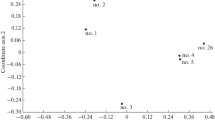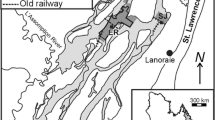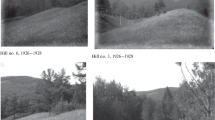Abstract
A description of the bog-pine (Pinus uncinata var.rotundata) dominated vegetation of uncut oligotrophic mires affected by drainage is given. Surveys were carried out at 17 sites along the Jura Mountains (Switzerland and France) in 1993, 1994, and 1995. Raised bogs of the Jura are generally of small size, and most vegetation changes in them have occurred as a result of the indirect impact of peat cutting. This activity led to the peat drying out and to colonization by trees, in particular by bog-pines.
Integrated synusial phytosociology was used to describe the vegetation where bog-pine, spruce, and birch occur. Two spatio-temporal levels of organization were considered: the synusia and the phytocoenosis. At the phytocoenosis level, four vegetation types representing bog-pine stands of uncut and deep oligotrophic peats are described with their constitutive synusial composition. They represent: (1) phytocoenoses developing in the open, wet central parts of the bogs, where trees are scattered and of small size, (2) phytocoenoses with layered tree stands of medium size and with a higher density, and (3) phytocoenoses with tall trees, developing generally near the edge of the bogs or close to peat cuttings. A generalized qualitative dynamic model of the vegetation in relation to the development of bog-pine trees was developed. It shows the spatial and temporal organization of the constituent synusiae, as well as other underlying hypothetical functional relations.
The different bog-pine-dominated vegetation types described in this study appear to have coexisted since the origin of the Jura bogs as a result of local polyclimaxes induced by differential waterlogged situations. They probably all belong to the same (primary) successional series, but have been affected by both autogenic and allogenic processes. During the development of the bogs the balance between the different communities changed. In particular, the vegetation types with dense and tall pine trees have undergone a drastic expansion since the Jura bogs were first affected by drainage.
Similar content being viewed by others
References
Andrus R.E., Wagner D.J. &Titus J.E. (1983): Vertical zonation ofSphagnum mosses along hummock-hollow gradients.Canad. J. Bot. 61: 3128–3139.
Barkman J.J. (1973): Synusial approaches to classification. In:Whittaker R.H. (ed.),Classification of plant communities, Junk, The Hague, pp. 435–491.
Bégeot C. &Richard H. (1996): L’origine récente des peuplements de Pin à crochets (Pinus uncinata Müller exMirbel) sur la tourbière de Frasne et exploitation de la tourbe dans le Jura.Acta Bot. Gallica 143: 47–53.
Buttler A., Cornali P. &Richard J.-L. (1983): La tourbière des Pontins sur St-Imier.Matér. Levé Géobot. Suisse 59: 1–79.
Braun-Blanquet J. (1964):Pflanzensoziologie. Grundzüge der Vegetationskunde. Ed. 3. Springer Verlag, Wien.
Chastain A. (1952): Recherches écologiques et floristiques sur le “Pinetum” de la Haute-tourbière de la Vraconnaz (Jura helvétique vaudois).Recueil Trav. Inst. Bot. Univ. Montpellier, Supplément 2: 1–176.
Corley M.F.V., Crundwell A.C., Düll R., Hill M.O. &Smith A.J.E. (1981): Mosses of Europe and the Azores: an annotated list of species, with synonyms from the recent literature.J. Bryol. 11: 609–689.
Dang Q.L. &Lieffers V.J. (1989): Assessment of patterns of response of tree ring growth of black spruce following peatland drainage.Canad. J. Forest Res. 19: 924–929.
Dierssen K. (1977): KlasseOxycocco-Sphagnetea. In:Oberdorfer E. (ed.),Süddeutsche Pflanzengesellschaften 1, Ed. 2. Gustav Fischer Verlag, Stuttgart., pp. 273–292.
Dierssen K. (1980): Some aspects of the classification of oligotrophic and mesotrophic mire communities in Europe.Colloq. Phytosoc. 7: 399–423.
Ellenberg H. (1978):Vegetation Mitteleuropas mit den Alpen in ökologischer Sicht. Ed. 2. Eugen Ulmer, Stuttgart.
Ellenberg H., Weber H.E., Düll R., Wirth V., Werner W. &Paulissen D. (1991): Zeigerwerte von Pflanzen in Mitteleuropa.Scripta Geobot. 18: 1–258.
Feldmeyer-Christe E. (1990): Etude phytoécologique des tourbières des Franches-Montagnes (cantons du Jura et de Berne, Suisse).Matér. Levé Géobot. Suisse, 66: 1–163.
Freléchoux F. (1997):Etude du boisement des tourbières hautes de la chaîne jurassienne: typologie et dynamique de la végétation — approche dendroécologique des peuplements arborescents. PhD. Thesis, Université de Neuchâtel, Neuchâtel.
Freléchoux F., Buttler A., Schweingruber F.H. &Gobat J.-M. (2000): Stand structure, invasion, and growth dynamics of bog-pine (Pinus uncinata var.rotundata) in relation to peat cutting and drainage in the Jura Mountains, Switzerland.Canad. J. Forest Res. 30: 1114–1126.
Giertych M. (1967): Generative reproduction. In:Białobok S. &Żelawski W. (eds.),Outline of physiology of Scots pine, PWN, Poznań, pp. 303–330.
Gillet F., De Foucault B. &Julve P. (1991): La phytosociologie synusiale intégrée: objets et concepts.Candollea 46: 315–340.
Gillet F. &Gallandat J.D. (1996): Integrated synusial phytosociology: some notes on a new multiscalar approach to vegetation analysis.J. Veg. Sci. 7: 13–18.
Grolle R. (1983): Hepatics of Europe including the Azores: an annotated list of species, with synonyms from the recent literature.J. Bryol. 12: 403–459.
Grünig P.E. (1955): Über den Einfluss der Entwässerung auf die Flachmoorvegetation und auf den Zuwachs der Fichte und Bergföhre im Flyschgebiet der Voralpen.Mitt. Schweiz. Anst. Forstl. Versuchswesen 31: 419–476.
Grünig A., Vetterli L. &Wildi O. (1984):Inventaire des hauts-marais et marais de transition de Suisse. Swiss Federal Institute for Forest, Snow and Landscape, Birmensdorf.
Grünig A., Vetterli L. &Wildi O. (1986):Les hauts-marais et marais de transition de Suisse. Report of the Swiss Federal Institute for Forest, Snow and Landscape, Birmensdorf.
Guinochet M. (1955):Carte des groupements végétaux de la France. Pontarlier 5–6, 1/20.000. CNRS, Paris.
Guinochet M. (1973):Phytosociologie. Masson, Paris.
Krisaï R. (1960): Pflanzengesellschaften aus dem Ibmer Moor.Jahrb. Oberösterr. Musealvereins 105: 155–208.
Landolt E. (1977): Ökologische Zeigerwerte zur Schweizer Flora.Veröff. Geobot. Inst. ETH, Stiftung Rübel Zürich 64: 1–208.
Lieffers V.J. &Rothwell R.L. (1986): Effects of depth of water table and substrate temperature on root and top growth ofPicea mariana andLarix laricina seedlings.Canad. J. Forest Res. 16: 1201–1206.
Lieffers V.J. &Rothwell R.L. (1987): Rooting of peatland black spruce and tamarack in relation to depth of water table.Canad. J. Bot. 65: 817–821.
McNally A. &Doyle G.J. (1984a): A study of sub-fossil pine layers in a raised bog complexe in the Irish midlands: 1. Palaeowoodland extent and dynamics.Proc. Roy. Irish Acad. Sect. B 84 (6–7): 57–70.
McNally A. &Doyle G.J. (1984b): A study of sub-fossil pine layers in a raised bog complexe in the Irish midlands: 2. Seral relationships and floristics.Proc. Roy. Irish Acad. Sect. B 84 (6–7): 71–81.
Matthey W. (1964): Observations écologiques dans la tourbière du Cachot.Bull. Soc. Neuchâteloise Sci. Nat. 87: 103–133.
Matthey W. (1971): Ecologie des insectes aquatiques d’une tourbière du Haut-Jura.Rev. Suisse Zool. 78: 367–536.
Mitchell E.A.D., van der Knaap W.O., van Leeuwen J.F.N., Buttler A., Warner B.G. & Gobat J.-M. (in press): The palaeoecological history of Praz-Rodet bog (Swiss Jura) based on pollen, plant macrofossils and testateAmoeba (Protozoa). The Holocene.
Moore J.J. (1968):A classification of the bogs and wet heaths of northern Europe. Pflanzensoziologische Systematik, Den Haag, pp. 306–320.
Munaut A.V. &Casparie W.A. (1971): Etude dendrochronologique desPinus silvestris subfossiles provenant de la tourbière d’Emmen (Drenthe, Pays-Bas).Rev. Palaeobot. Palynol. 11: 201–226.
Müller-Dombois D. (1964): Effects of depth of water table on heigh growth of tree seedlings in a greenhouse.Forest Sci. 10: 306–316.
Neuhäusl R. (1969): Systematisch-soziologische Stellung der baumreichen Hochmoorgesellschaften Europas.Vegetatio 18: 104–121.
Neuhäusl R. (1972): Subkontinentale Hochmoore und ihre Vegetation.Stud. Českoslov. Akad. Věd 13: 1–121.
Neuhäusl R. (1992): Primary and secondary succession on wooded peat-bogs.Acta Soc. Bot. Poloniae 61: 89–102.
Oberdorfer E. (1957): Süddeutsche Pflanzengesellschaften.Pflanzensoziologie 10: 1–564.
Oberdorfer E. (ed.) (1977): Süddeutsche Pflanzengesellschaften 1. Ed. 2. G. Fischer Verlag, Stuttgart.
Oberdorfer E. (ed.) (1992)Süddeutsche Pflanzengesellschaften 4. Ed. 2. G. Fischer Verlag, Stuttgart.
Ohlson M. &Zackrisson O. (1992): Tree establishment and microhabitat relationships in north Swedish peatland.Canad. J. Forest Res. 22: 1869–1877.
Payandeh B. (1973): Analyses of a forest drainage experiment in northern Ontario I. Growth analysis.Canad. J. Forest Res. 3: 387–398.
Pilcher J.R., Baillie M.G.L., Brown D.M., McCormac F.G., MacSweeney P.B. &McLawrence A.S. (1995): Dendrochronology of subfossil pine in the north of Ireland.J. Ecol. 83: 665–671.
Richard J.-L. (1961): Les forêts acidophiles du Jura.Matér. Léve Géobot. Suisse 38: 1–164.
Reille M. (1991): L’origine de la station de pin à crochets de la tourbière de Pinet (Aude) et de quelques stations isolées de cet arbre dans les Vosges et le Jura.Bull. Soc. Bot. France 138,Lettres Bot. 2: 123–148.
Royer J.-M., Vadam J.-C., Gillet F., Aumonier J.-P. &Aumonier M.-F. (1978): Etude phytosociologique des tourbière acides du Haut-Doubs. Réflexions sur leur régénération et leur génèse.Doc. Phytosoc. 7: 295–344.
Sandoz H. (1982): Le complexe des Pins dits “de montagne”. Analyse historique des principaux binômes utilisés:Pinus montana Müller,Pinus mugo Turra,Pinus mughus Scopoli,Pinus pumilio Haenke etPinus uncinata Ramond.Rev. Gén. Bot. 89: 121–129.
Sandoz H. (1987):Recherches taxonomiques, biogéographiques et phytoécologiques sur les principaux conifères subalpins des Alpes: mélèze d’Europe, pin cembro, pin à crochets et pin mugho. PhD. Thesis, Université d’Aix-Marseille III, Marseille.
Schmid J., Bogenrieder A. &Schweingruber F.H. (1995): Verjüngung und Wachstum von Moor-Kiefer (Pinus rotundata Link) und Fichten (Picea abies (L.) H.Karsten) in Mooren des Südöstlichen Schwarzwaldes (Süddeutschland).Mitt. Eidgenöss. Forsch. Anst. Wald Schnee Landschaft 70: 175–223.
Schneebeli M. (1991):Hydrologie und Dynamik der Hochmoorentwicklung. PhD. Thesis, ETH, Zürich.
Schulthess J. (1990):Der Einfluss von Entwässerung auf Bewaldung eines Hochmoores: Eine Studie zur rezenten Bewaldungsentwicklung am Etang de la Gruère (JU). MSc. Thesis, Geogr. Inst. Univ. Zürich-Irchel, Zürich.
Schweingruber F.H. (1996):Tree rings and environment, dendroecology. Swiss Federal Institute for Forest, Snow and Landscape Research, Berne, Stuttgart, Vienna, Haupt.
Seppala K. (1969): Postdrainage growth of Norway spruce and Scots pine on peat.Acta Forest. Fenn. 93: 1–89.
Stanek W. (1977): Ontario clay belt peatlands — are they suitable for forest drainage?Canad. J. Forest Res. 7: 656–665.
Stravinskene V.P. (1983): Dynamics of early and late wood in the annual rings of trees and its change due to the forest drainage.Soviet J. Ecol. 14: 324–328.
Tutin T.G., Heywood V.H., Burges N.A., Valentine D.H., Walters S.M. &Webb D.A. (eds.) (1964–1980):Flora europaea 1–5. Cambridge University Press, Cambridge.
Westhoff V. &van der Maarel E. (1978): The Braun-Blanquet approach. In:Whittaker R.H. (ed.),Classification of plant communities, Junk, The Hague, pp. 287–399.
Wildi O. (1989): A new numerical solution to traditional phytosociological tabular classification.Vegetatio 81: 95–106.
Wildi O. &Orlóci L. (1996):Numerical exploration of community patterns. A guide to the use of MULVA-5. SPB Academic Publishing, The Hague.
Zobel M. (1988): Autogenic succession in boreal mires — a review.Folia Geobot. Phytotax. 23: 417–445.
Author information
Authors and Affiliations
Corresponding author
Rights and permissions
About this article
Cite this article
Freléchoux, F., Buttler, A. & Gillet, F. Dynamics of bog-pine-dominated mires in the Jura Mountains, Switzerland: A tentative scheme based on synusial phytosociology. Folia Geobot 35, 273–288 (2000). https://doi.org/10.1007/BF02803119
Received:
Revised:
Accepted:
Issue Date:
DOI: https://doi.org/10.1007/BF02803119




